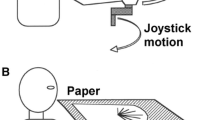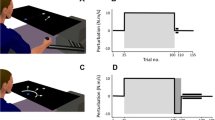Abstract
Two deafferented patients and several control subjects participated in a series of experiments to investigate how accurate single-joint movements are programed, spatially calibrated, and updated in the absence of proprioceptive information. The deafferented patients suffered from a permanent and severe loss of large sensory myelinated fibers below the neck. Subjects performed, with and without vision, sequences of forearm supinations and pronations with two temporal delays between each movement (0 s and 8 s). Overall, the lack of proprioception did not yield any significant decrease in movement accuracy when vision was available. Without vision, the absence of proprioceptive afferents yielded (1) significantly larger spatial errors, (2) amplitude errors similar to those of control subjects, and (3) a significant drift when an 8-s delay was introduced between two successive movements. Subjects also performed, without vision, a 20∘ supination followed by a 20∘ pronation that brought back the wrist to the starting position. On some trials, the supination was blocked unexpectedly by way of a magnetic brake. When the supination was blocked, subjects were already on the second target and no pronation was required when the brake was released. The defferented patients, unaware of the procedure, always produced a 20∘ pronation. These data confirm that deafferented patients were not coding a final position. It rather suggests that they coded an amplitude and translated the spatial distance between the two targets in a corresponding force pulse. Overall, the results highlight the powerful and key role of proprioceptive afferents for calibrating the spatial motor frame of reference.
Similar content being viewed by others
References
Bard C, Fleury M, Teasdale N, Paillard J, Nougier V (1995) The contribution of proprioception for calibrating and updating the motor space. Can J Physiol Pharmacol 73: 246–254
Bizzi E, Accornero N, Chapple W, Hogan N (1984) Posture control and trajectory formation during arm movements. J Neurosci 4: 2738–2744
Bizzi E, Hogan N, Mussa-Ivaldi FA, Giszter S (1992) Does the nervous system use equilibrium-point control to guide single and multiple joint movements? Behav Brain Sci 15: 603–613
Bizzi E, Polit A, Morasso P (1976) Mechanisms underlying achievement of final head position. J Neurophysiol 39: 435–444
Blouin J, Bard C, Teasdale N, Paillard J, Fleury M, Forget R, Lamarre Y (1993) Reference systems for coding spatial information in normal subjects and a deafferented patient. Exp Brain Res 93: 324–331
Bock O, Dose M, Ott D, Eckmiller R (1990) Control of arm movements in a 2-dimensional pointing task. Behav Brain Res 40: 247–250
Bock O, Eckmiller R (1986) Goal-directed arm movements in absence of visual guidance: evidence for amplitude rather than position control. Exp Brain Res 62: 451–458
Carlton L (1992) Visual processing time and the control of movement. In: Proteau L, Elliott D (eds) Vision and motor control. North-Holland, Amsterdam, pp 3–31
Cole J, Sedgwick E (1992) The perceptions of force and of movement in a man without large myelinated sensory afferents below the neck. J Physiol (Lond) 449: 503–515
Cooke JD, Brown S, Forget R, Lamarre Y (1985) Initial agonist burst duration changes with movement amplitude in a deafferented patient. Exp Brain Res 60: 184–187
Cordo PJ (1990) Kinesthesic control of a multijoint movements sequence. J Neurophysiol 63: 161–171
Cruse H, Dean J, Heuer H, Schmidt R (1990) Utilization of sensory information for motor control. In: Neumann O, Prinz W (eds) Relationships between perception and action. Springer, Berlin Heidelberg New York, pp 43–79
Feldman A (1966) Functional tuning of the nervous system during control of movement or maintenance of a steady posture II. Biofizika 11: 498–508
Feldman A (1986) Once more on the equilibrium-point hypothesis (1 model) for motor control. J Mot Behav 18: 17–54
Feldman A (1992) Fundamentals of motor control, kinesthesia and spinal neurons: in search of a theory. Behav Brain Sci 15: 735–737
Feldman A, Levin M (1995) The origin and use of positional frames of reference in motor control. Brain Behav Sci 18: 723–806
Flash T (1989) Generation of reaching movements: plausibility and implications of the equilibrium trajectory hypothesis. Brain Behav Evolut 33: 63–68
Fleury M, Macar F, Bard C, Teasdale N, Paillard J, Lamarre Y (1994) Production of short timing responses: a comparative study with a deafferented patient. Neuropsychologia 32: 1435–1440
Forget R, Lamarre Y (1987) Rapid elbow flexion in the absence of proprioceptive and cutaneous feedback. Hum Neurobiol 6: 27–37
Gandevia SC, Burke D (1992) Does the nervous system depend on kinesthetic information to control natural limb movements? Behav Brain Sci 15: 614–632
Gandevia SC, McCloskey D (1977) Sensations of heaviness. Brain 100: 345–354
Gentilucci M, Toni I, Chieffi S, Pavesi G (1994) The role of proprioception in the control of prehension movements: a kinematic study in a peripherally deafferented patient and in normal subjects. Exp Brain Res 99: 483–500
Georgopoulos A, Schwartz A, Kettner R (1986) Neuronal population coding of movement direction. Science 233: 1416–1419
Ghez C, Felice-Ghilardi M, Gordon J (1995) Impairments of reaching movements in patients without proprioception. II. Effects of visual information on accuracy. J Neurophysiol 73: 361–372
Ghez C, Gordon J (1987) Trajectory control in targeted force impulses. I. Role of opposing muscles. Exp Brain Res 67: 225–240
Ghez C, Gordon J, Ghilardi M, Christakos C, Cooper S (1990) Roles of proprioceptive input in the programming of arm trajectories. Cold Spring Harb Symp Quant Biol 55: 837–847
Gordon J, Felice-Ghilardi M, Ghez C (1995) Impairments of reaching movements in patients without proprioception. I. Spatial errors. J Neurophysiol 73: 347–360
Gordon J, Iyer M, Ghez C (1987) Impairment of motor programming and trajectory control in a deafferented patient. Soc Neurosci Abstr 13: 352
Jaric S, Corcos D, Gottlieb G, Ilic D, Latash M (1994) The effects of practice on movement distance and final position reproduction: implications for the equilibrium-point control of movement. Exp Brain Res 100: 353–359
Jeannerod M (1988) The neural and behavioural organization of goal directed movements. Oxford Science, Oxford
Kelso JAS (1977) Motor control mechanisms underlying human movement production. J Exp Psychol Hum Percept Perform 3: 529–543
Kelso JAS, Holt K (1980) Exploring a vibratory systems analysis of human movement production. J Neurophysiol 43: 1183–1196
Laabs G (1973) Retention characteristics of different reproduction cues in motor short-term memory. J Exp Psychol 100: 168–177
Larue J, Bard C, Fleury M, Teasdale N, Paillard J (1992) Rôle des afférences proprioceptives et cutanés dans le contrôle des mouvements de pointage en amplitude. In: Laurent M, Marini JF, Pfister R, Therme P (eds) Recherches en APS 3. Université Aix-Marseille, Paris, Actio, pp 101–109
Lashley K (1917) The accuracy of movement in the absence of excitation from the moving arm. Am J Physiol 43: 169–194
Latash M, Gottlieb G (1991) An equilibrium-point model for fast, single-joint movement. I. Emergence of strategy-dependent EMG patterns. J Mot Behav 23: 163–177
McNeilage P (1970) Motor control of serial ordering of speech. Psychol Rev 77: 182–196
Meyer D, Abrams R, Kornblum S, Wright C, Smith J (1988) Optimality in human motor performance: ideal control of rapid aimed movements. Psychol Rev 95: 340–370
Paillard J (1991) Motor and representational framing of space. In: Paillard J (ed) Brain and space. Oxford University Press, Oxford, pp 163–182
Polit A, Bizzi E (1979) Characteristics of motor programs underlying arm movements in monkeys. J Neurophysiol 42: 183–194
Rothwell JL, Traub MM, Day BL, Obeso JA, Thomas PK, Marsden CD (1982) Manual motor performance in a deafferented man. Brain 105: 515–542
Sainburg RL, Poizner H, Ghez C (1993) Loss of proprioception produces deficits in interjoint coordination. J Neurophysiol 70: 2136–2147
Sanes JN (1990) Motor representations in deafferented humans: a mechanism for disordered movement performance. In: Jeannerod M (ed) Motor representation and control. (Attention and performance XIII) Erlbaum, Hillsdale, NJ, pp 714–735
Sanes JN, Mauritz K-H, Dalakas MC, Evarts EV (1985) Motor control in humans with large-fiber sensory neuropathy. Hum Neurobiol 4: 101–114
Sokal RR, Rohlf J (1981) Biometry. Freeman, San Francisco
Sperry RW (1969) An emergent theory of conciousness. Psychol Rev 76: 532–536
Taub E, Berman A (1968) Movement and learning in the absence of sensory feedback. In: Freedman S (ed) The neuropsychology of spatially oriented behavior. Dorsey, Homewood, pp 173–192
Taub E, Goldberg I, Taub P (1975) Deafferentation in monkeys: pointing at a target without visual feedback. Exp Neurol 46: 178–186
Teasdale N, Forget R, Bard C, Paillard J, Fleury M, Lamarre Y (1993) The role of proprioceptive information for the production of isometric forces and for handwriting tasks. Acta Psychol 82: 179–191
Teuber HL (1974) Key problems in the programming of movements. Brain Res 71: 553–568
Von Holst E (1939) Die relative Koordination als Phänomen und als Methode zentralnervöser Funktionanalyse. Ergebn Physiol 42: 228–306
Author information
Authors and Affiliations
Rights and permissions
About this article
Cite this article
Nougier, V., Bard, C., Fleury, M. et al. Control of single-joint movements in deafferented patients: evidence for amplitude coding rather than position control. Exp Brain Res 109, 473–482 (1996). https://doi.org/10.1007/BF00229632
Received:
Accepted:
Issue Date:
DOI: https://doi.org/10.1007/BF00229632




